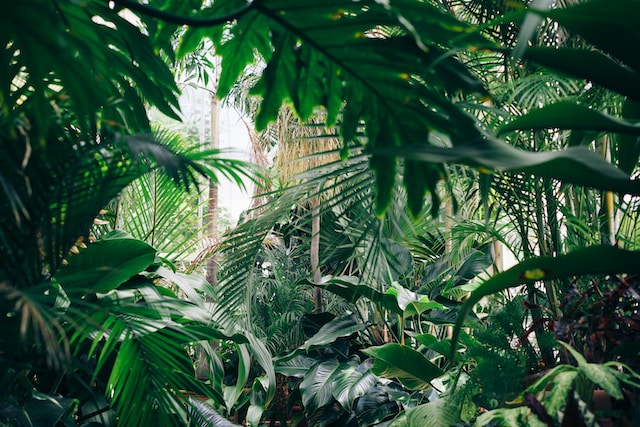Having a tropical garden, or even a garden with some tropical elements, has always been an aim of mine.
Living in the north of the UK this can present some challenges in terms of climate, but there are many plants that look the part that can cope with cooler temperatures.
In this article we will look how to create a tropical garden, wherever you are!
Tropical gardens are characterised by large leaves, deep greens and bright exotic flowers. Palm trees and ferns along with water features provide a lush and vivid environment.
Key Elements Of Tropical Gardens
Let’s have a look at the key elements that make up a tropical garden.
Lush Foliage:
- Tropical gardens are mainly characterised by their abundant greenery.
- Large, bold leaves and vibrant foliage are essential components.
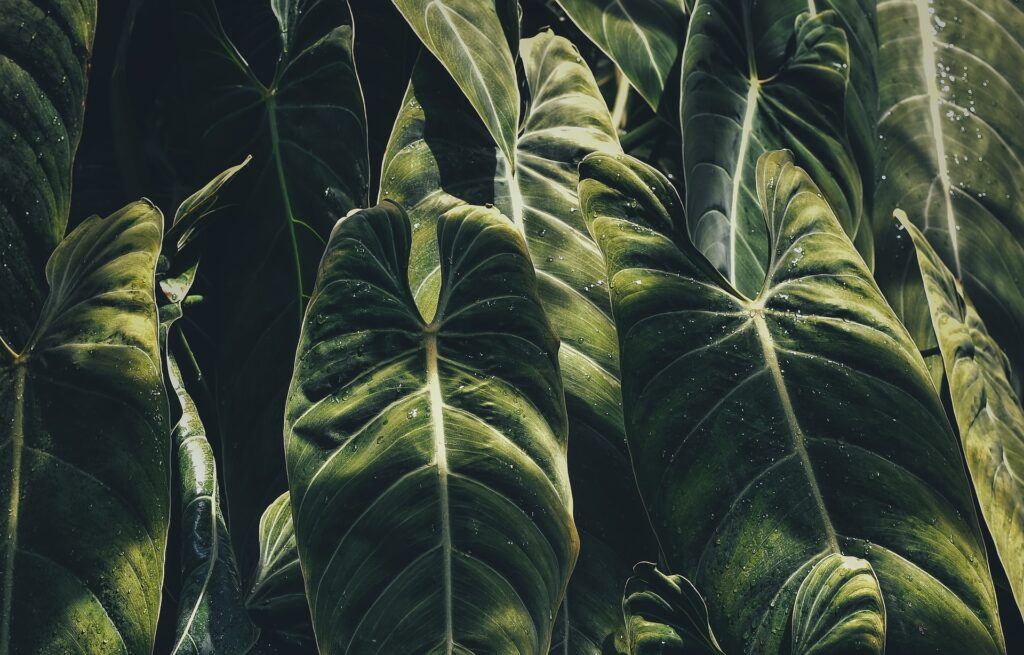
Colourful Flowers
- Tropical gardens are known for their vibrant and exotic flowers.
- Often the colour will be in the warmer range – ranging from bold reds and oranges to softer pastels, depending on your preference.
Water Features
- Many tropical gardens incorporate water features, such as ponds, fountains, or small streams, to create a sense of tranquility.
Exotic Plants
- Tropical gardens often feature exotic and rare plant species that thrive in warm, humid climates.
- In colder areas a similar effect can be achieved by using unusual looking and colourful border planting.

Layered Planting
- Layering plants with various heights and sizes creates depth and visual interest in tropical gardens.
- This can also help disguise and cover fences, making it feel as if you are deep in the jungle!
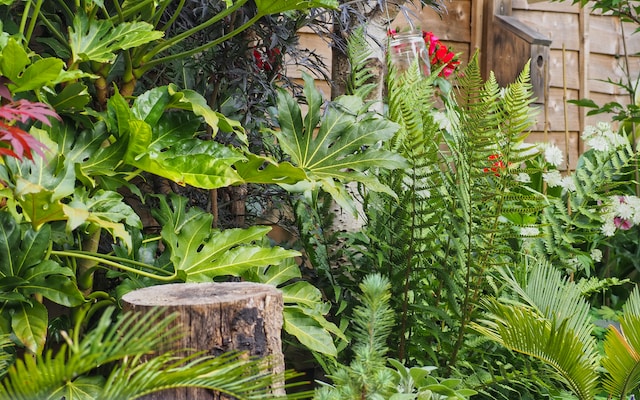
Natural Materials
- Incorporating natural materials like stone, wood, and bamboo in hardscape elements adds an authentic touch.
Wildlife and Biodiversity
- Tropical gardens often attract various forms of wildlife, from butterflies and birds to lizards and frogs.
Sound
- A recognisable element of tropical environments is a rich sound background of birdsong, insects and other wildlife noises.
- This can also include the sound of running water.
Step By Step Process Of Creating A Tropical Garden
Site Assessment
Before you start planning your tropical garden, assess your site to understand its unique conditions and limitations:
Climate
- Determine your climate zone and understand the temperature and rainfall patterns in your area.
- Tropical plants thrive in warm, humid conditions but substitutions can be made for colder climates.
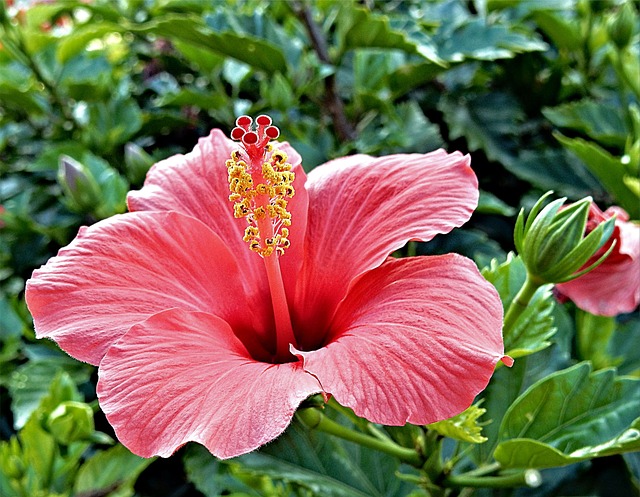
Sunlight
- Analyze the amount and intensity of sunlight your garden receives throughout the day.
- Most tropical palms prefer partial to full sunlight, however ground cover plants like ferns are very happy in medium to deep shade.
Soil Quality
- Assess your soil’s composition and drainage.
- Tropical plants often require well-draining soil rich in organic matter.
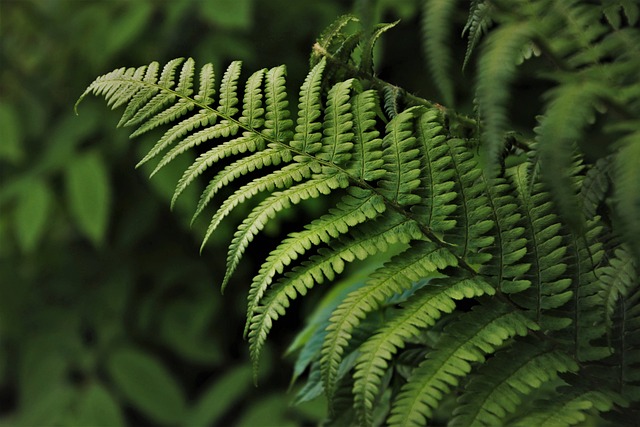
Space
- Consider the size and layout of your garden.
- Decide if you want to create a full-scale tropical paradise or to incorporate tropical elements into an existing garden.
- You could just have a dedicated area for tropical planting.
Budget
- Establish a budget for your project, as tropical plants and exotic features can be costly.
- Remember you can build the garden up over time, and add to it as you go.
- Look out for palm trees and other large statement pieces on local Buy Swap and Sell groups in your area, you can often get free plants, stones or furniture that other people have finished with.
Garden Design and Layout
Once you have a clear understanding of your site, it’s time to plan the design and layout of your tropical garden:
Choose a Theme
- Decide on a specific tropical theme for your garden.
- You can opt for a more traditional, Asian, or modern tropical design, depending on your preferences.
Make a Plan
- Draw a simple plan to give yourself a rough idea of where each element will go.
- You can always change it later but this will give you some structure and ensure you are getting the best out of what you have available.
- Plan seating areas where you can relax and enjoy your garden.
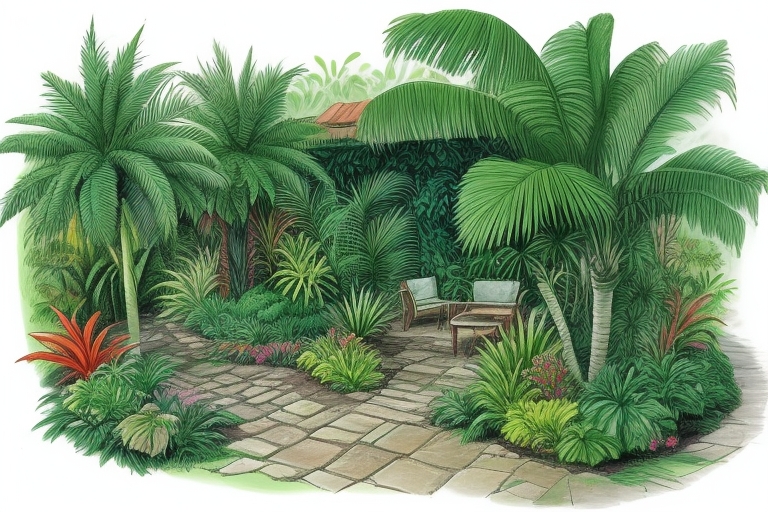
Create a Focal Point
- Identify a central focal point, such as a water feature, sculpture, or seating area, to anchor your garden design.
Planting Zones
- Research and choose a variety of tropical plants that suit your climate and design vision.
- Include a mix of trees, shrubs, and ground cover plants.
- Designate specific areas for planting, considering the height and growth habits of each plant.
- Create layers by placing taller plants at the back and lower plants in the front.
Hardscape Elements
- Incorporate natural materials like stone pathways, wooden decks, and bamboo screens to enhance the tropical ambience.
Water Features
- If space allows, consider adding a pond, waterfall, or fountain to create a calming atmosphere.
Plant Selection and Care
Choosing the right plants is crucial to achieving the tropical look and feel in your garden:
Tropical Trees
- Select large, canopy trees like palms, banana plants, or jacaranda to provide shade and height to your garden.
- For colder climates like the UK, there are many hardy palms that will be fine outside as long as they are in sun and the soil is free draining. Trachycarpus fortunei is one such example.
- Tree ferns are a great choice and can handle UK temperatures if looked after correctly.
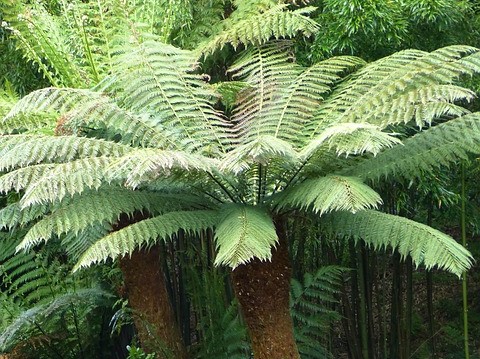
Shrubs and Bushes
- If you are lucky enough to live in a warm climate you can include a mix of tropical shrubs and bushes, such as hibiscus, bougainvillea, and bird of paradise, to add colour and texture.
- If you are in cooler parts of the world, consider having plants in pots that you can bring in for the winter.
- Some tropical looking plants are surprisingly hardy and will easily survive colder temperatures.
- Fatsia Japonica are a great choice as they have lush tropical leaves but are hardy enough for UK winters.
- Yucca gloriosa is another great example of a large spiky tropical looking plant that is actually more at home in the desert, but will be fine through the winter.
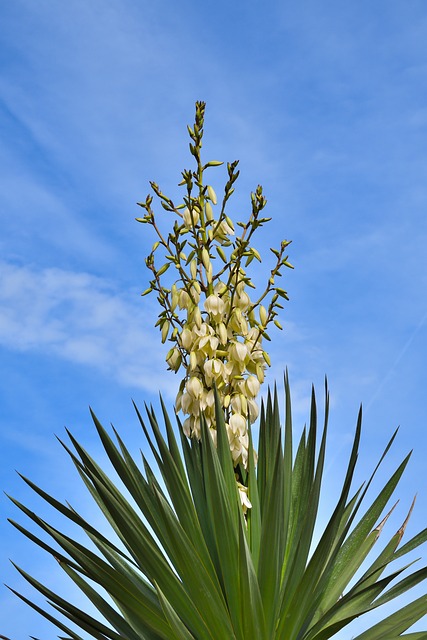
Groundcover Plants
- Opt for low-growing groundcover plants like mondo grass, elephant ears, or hostas to fill in gaps and create lushness.
- For colder climates ferns are a brilliant choice and actually grow wild in most of the UK, so are perfectly adapted to our cold and wet conditions.
- Other great options that you may not think of are edibles like rhubarb and chard. Both rhubarb and chard have large green tropical looking leaves that go perfectly in a jungle setting. You can also enjoy the pink stems visually as well as harvesting them to eat.
- Lobelias would fit well with their vivid red flowers and dark stems.
- I like to grow nasturtiums in borders as I think the round leaves and orange, red and yellow flowers are very tropical looking.
Vines and Climbers
- Use climbing plants like jasmine, passionflower, or trumpet vine to cover walls, fences, or trellises.
- If you have shaded areas, take a look at our article on the best climbing plants for shade.

Perennials
- Incorporate perennial tropical plants like canna lilies, ginger, and heliconia for long-lasting colour and interest.
- Cannas can be grown in pots and brought in for the winter, or save the seed pods and regrow again.
Annuals
- Plant annuals such as impatiens, begonias, and coleus for seasonal bursts of colour.
- In colder areas geraniums do very well, as long as they have sunlight and free draining soil.
Maintenance
- Regularly prune and care for your plants to keep them healthy and maintain their shape.
- Mulching can help retain moisture and suppress weeds.
Soil Preparation
To ensure your tropical plants thrive, prepare the soil accordingly:
Soil Testing
- Conduct a soil test to determine its pH and nutrient levels.
- Adjust the pH if necessary to meet your plant’s requirements.
Amendments
- Add organic matter like compost or well-rotted manure to improve soil fertility and structure.
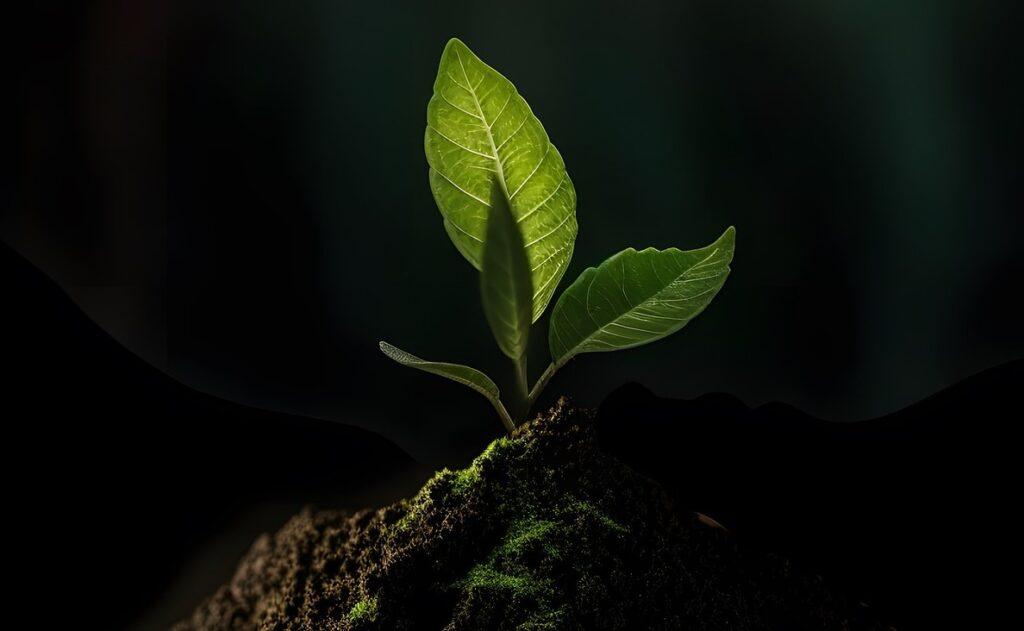
Drainage
- Ensure that your garden bed has proper drainage to prevent waterlogged soil, which can harm tropical plants.
Irrigation and Watering
Tropical plants typically require consistent moisture, so a well-thought-out irrigation system is crucial:
Drip Irrigation
- One option is to install a drip irrigation system to deliver water directly to the base of your plants, minimising water wastage.
Mulching
- Apply a layer of mulch around your plants to retain moisture, regulate soil temperature, and reduce weed growth.
Monitor Soil Moisture
- Regularly check the moisture level of the soil to adjust your watering schedule accordingly.
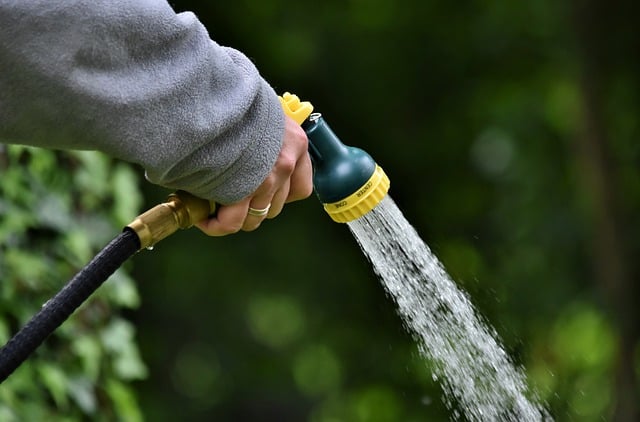
Maintenance and Care
Maintaining a tropical garden requires ongoing care and attention:
Pruning
- Trim and prune plants to maintain their shape, remove dead or diseased growth, and encourage new growth.
Fertilising
- Apply a balanced, slow-release fertiliser to provide essential nutrients to your plants during the growing season.
Pest and Disease Management
- Monitor your garden for pests and diseases and take prompt action to control and prevent infestations.
Weed Control
- Regularly weed your garden beds to prevent unwanted competition for nutrients and moisture.
Wildlife Attraction
Tropical gardens often attract various forms of wildlife, enhancing their appeal:
Bird Feeders
- Install bird feeders to attract birds to your garden.
Butterfly Plants
- Include butterfly-friendly plants like milkweed, pentas, and butterfly bush (buddleia) to invite these beautiful insects.
- Another way to attract butterflies is to put out sliced fruit like watermelon, oranges or pineapple.
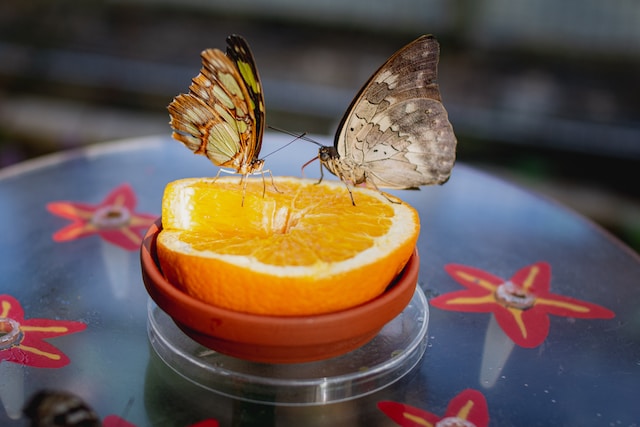
Fish Ponds And Water Features
- If you have a pond, consider adding colorful koi or goldfish to create a tranquil aquatic environment.
- Even a small container with water in it and some plants will attract dragonflies, birds and other animals as they come to have a drink.
Lighting, Seating and Accessories
To make your tropical garden a paradise both day and night, consider adding lighting, seating and accessories:
Outdoor Lighting
- Install pathway lighting, fairy lights, or lanterns to create a magical atmosphere in the evenings.
- You can use uplighters to highlight trees and ferns in different colours.
- Solar lights are great for keeping costs low.

Decorative Elements
Incorporate decorative elements like statues, wind chimes, and sculptures to add personality to your garden.
Seating Areas
- With large lush planting it is easy to create different seating areas that are screened off from the house or other people.
- This really gives the feeling of being in a jungle far away.
- It could be a simple chair, bench or even a cool rock.
- Hammocks are another great option.
- Bright cushions can add pops of colour to compliment the planting.
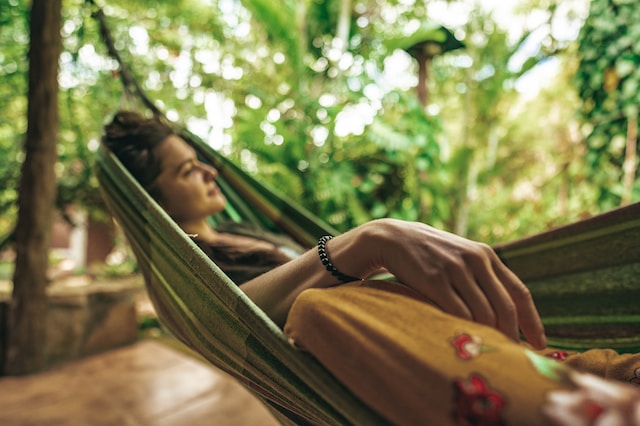
Conclusion
Creating a tropical garden is a labour of love that rewards you with a lush and inviting outdoor oasis.
You can bring the beauty, colour, texture, sound and scents of the tropics to your own backyard, no matter where you live.
Check out our other articles to learn how to create your own Mediterranean garden, flower garden or Zen garden!

